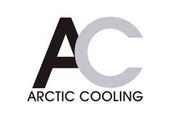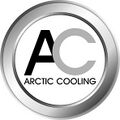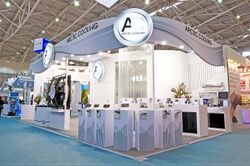Arctic
Topic: Company
 From HandWiki - Reading time: 8 min
From HandWiki - Reading time: 8 min
 Logo introduced in 2017 | |
| Type | Private, GmbH |
|---|---|
| Industry |
|
| Founded | 2001 |
| Headquarters | Bevenroder Straße 149, Braunschweig, Germany |
Area served | Worldwide |
Key people | Magnus Huber (Managing director) |
| Products | |
| Website | arctic |
Arctic GmbH, formerly known as Arctic Cooling,[1] is a German, Swiss-founded manufacturer of computer cooling components, mainly CPU and graphics card coolers,[2] case fans and thermal compound. Since 2010, Arctic expanded its business by starting a range of products to cater other consumer demands beyond that of computer cooling hardware. Nowadays, Arctic also offers various consumer products[3]—spanning audio,[4] home entertainment[5] and computer peripherals.[6] In 2012, Arctic was nominated as one of the finalists in the annual PCR Awards.[7]
Founded in 2001, Arctic has offices in Germany, Hong Kong and the United States and cooperates with different production facilities in China. Arctic products are distributed worldwide through distributors,[8] dealers and retailers. The United States, United Kingdom and Germany are Arctic's major markets. The company has also collaborated with leading graphics card brands such as HIS,[9] Inno3D,[10] PowerColor,[11] VTX3D,[12] and Sapphire[13] in the development of OEM cooling equipment.
History
In 2001, Arctic Cooling was founded in Switzerland by Magnus Huber.[14] As the company name suggested, in the past, the business focused entirely on computer cooling solutions. Today, in order to expand the business into other areas especially in consumer electronics, by 2010, it began to develop a diverse range of products that spans beyond cooling into computer peripherals, audio products and home entertainment PCs. For this reason, Arctic Cooling was changed to Arctic in 2010.[15] Since 17.11.2015 Arctic Switzerland AG is in liquidation.[16]
Logo
Products
Computer cooling

Being the company's original focus, Arctic primarily designs and manufactures cooling products for computer hardware, with broad compatibility.[17] The company owned a number of patents for its fan and cooler designs[18] as well as for special technologies used in the air coolers including PWM sharing,[19] low noise impeller,[20] cross blow and anti-vibration technologies.[20]
Freezer
Freezer is a trademark of Arctic for its line of CPU coolers. It includes both the air cooler based on a heatpipe architecture as well as the water cooling solutions.
Alpine
Alpine is a trademark of Arctic for its line of CPU coolers based on Aluminum extrusion heatsink. It includes both active and passive coolers.
Accelero
Accelero is a trademark[21] of Arctic (formerly Arctic Cooling) for its line of graphics card coolers.[22] The Accelero line of coolers are targeted to high-end graphics cards based on GPUs from Nvidia and AMD.[23] The Accelero series utilizes different types of cooling technologies namely air cooling, passive cooling as well as[24] to offer different options for different customers. In 2006, Accelero X1 and Accelero X2 are the first VGA coolers introduced in the series by the manufacturer.[25][26] The Accelero series has collaborated in a number of OEM projects with motherboard and video card manufacturers to develop customized graphics card cooling solutions.[27][28][29][30] Arctic is the first video card cooler manufacturer to use a copper base for their heatsinks.[31]
In May 2012, ARCTIC released the Accelero Hybrid, which is claimed to be the world's first graphics card cooler with integrated air and liquid solution in the market.[32]
Features
Graphics card coolers are generally served as an upgrade or replacement for the stock cooler in order to reduce noise, temperature and enhance the overclocking capability of the GPU.[33] Arctic's heatsinks are claimed to provide quiet, high performance cooling,[34] which also makes the Accelero series one of the most popular graphics card coolers in the market.[35]
Thermal compound
Among the company's array of thermal compound, the MX-4 received the Top Product Award from the German magazine PC Games Hardware.[36][37]
- MX-6
- MX-4
- MX-2[38]
PC case
Fusion Power Supplies and Storage Devices
Fusion is Arctic's brand name for various cooling and data storage products, including the Fusion 550- EU, Fusion 550RF, Fusion 550R, Fusion 550F and Fusion 1TB (external hard drive),[41] and the Fusion 1TB data storage device.
Audio series
Arctic started to develop its audio products such as speakers, headphones and headsets since 2010 and it has expanded to wireless audio system near the end of 2011.[42]
Living series
In June 2011, Arctic entered the HTPC market with its first mini HTPC, MC001 Entertainment Center Series, which was first introduced in Computex 2011.[43] In 2012, Arctic introduced more advanced models with MC101 Series, AMD Trinity-powered HTPCs which are aimed for multimedia users. The MC101 Series features AMD Trinity A8/A10 APU, AMD Radeon HD 3D graphics, up to 1TB hard disk storage, SSD, up to 8GB DDR3 memory and built-in TV tuner.[44]
On top of the entertainment centers, Arctic offers as well an audio gateway that works as a Windows Media Center Extender : Audio Relay.[45] It is not DLNA certified but is compatible with the protocol.
Due to limited commercial success, this product line has been discontinued.
Computer peripherals
Arctic offers a selection of computer peripherals including keyboards, mice, USB fans, etc. In the end of 2011, the brand started to offer Apple accessories.
Power series
The Power series offers various USB travel adapters, car chargers and batteries.[46]
Patents and trademarks
The company has claimed several trademarks and patents for the name and technology applied to their products. Some of the air coolers and case fans produced by the company feature a patent design of the fan holder to achieve vibration absorption and elimination of the buzzing sound when the fan is running. The Freezer 7 Pro features 4 rubber connectors which serve as a vibration damper to absorb the vibration of the running fan and prevent the vibration from transferring to the heatsink and the case.[47] The Arctic F Pro PWM employs the same technology to absorb vibration and prevent it from transmitting across other components within the case.[48]
Arctic claims to be the patent holder of the PWM Sharing Technology, namely PST, which shares a single PWM signal with all the other PWM controlled devices connected to the motherboard to control all fan speeds and enhance the noise level according to the load.[49]
The Freezer 13 PRO CO employs the patented Cross-Blow technology by the use of an extra fan installed at the bottom of the heatsink to give a boost of cooling performance to the surrounding components, including Northbridge and voltage regulators.[50]
The company utilizes its patented passive cooling technology (DE 20200600) in the Accelero S1 PLUS to enhance the level of natural convection from the GPU by letting more air to pass through the aluminum fins so that heat will be dissipated more efficiently.[51]
Some of the key products including Freezer, Accelero, Alpine, Fusion and Silentium series are registered trademarks in the EU and the US.[52]
Branding
In 2011, Arctic has started to engage its end consumers through the means of social media (e.g. Facebook[53]) to reinforce the brand's awareness. The company was also a platinum partner with PCR Retail Boot Camp[54] – a new conference and expo for the UK PC and IT channel.
Collaborations
Arctic also produces cooling solutions for several graphic card manufactures; in most cases improving cooling beyond the OEM cooler. These include but are not limited to:
- AMD (formerly ATI)
- Club 3D
- ECS
- Galaxy
- Hightech Information System (HIS)
- Inno3D
- TUL (PowerColor)
- Sapphire Technology
- Sparkle
- Zotac
Partnership with OpenELEC
Due to the strategic mistake of bundling the MC001 with Microsoft Windows 7 and the high price the MC001 was very badly sold. To increase sales, on 5 February 2013, Arctic announced their new partnership with OpenELEC. Arctic worked with OpenELEC together and combined a fully passive cooled Entertainment system - the MC001 media centre (US and EU version) equipped with the latest XBMC 12 (OpenELEC 3.0) platform. Arctic and OpenELEC were planning on their next release, aimed to provide a more dedicated builds for the Arctic MC001 systems.[55][56][57][58][59][60][61] Shortly after partnershipping with OpenELEC, the development of passively cooled media centers was abandoned.
Dispute
Arctic was reportedly planning to file a lawsuit against Advanced Micro Devices (AMD) for the infringement of its trademark "Fusion", the name that AMD used to describe its series of APUs which integrate x86 processing cores with Radeon stream processors on the same piece of silicon.[62] In light of the lawsuit, AMD has announced earlier in 2012 its plans to drop its Fusion branding in favor of the Heterogeneous Systems Architecture (HSA).[63] On 23 January 2013, Arctic announced that the company and AMD arrived at a mutual agreement in settling the "Fusion" trademark dispute without any disclosure of the terms.[64]
References
- ↑ "Arctic Cooling Becomes Arctic" , "Hardware Secrets", 3 June 2010. Retrieved 10 May 2012
- ↑ "The 25 most wanted VGA cooler at Case King: Arctic Cooling Accelero Xtreme Plus is number 1" (German), "PC Games Hardware". Retrieved 17 May 2012
- ↑ "Arctic Headsets and Headphones Review", "Hardocp", 9 May 2011. Retrieved 10 May 2012
- ↑ "Arctic to develop wireless audio product line" , "Audio Pro International", 22 February 2012. Retrieved 10 May 2012.
- ↑ "Arctic unveils the MC101 Series Trinity-Powered HTPCs", "Tech Power Up", 1 February 2012. Retrieved 10 May 2012
- ↑ "Arctic Hobby Remote Control – discover your inner kid", "Kitguru", 12 January 2011. Retrieved 10 May 2012
- ↑ "PCR Awards 2012: The finalists"
- ↑ "Arctic goes exclusive with EntaTech", "Channel EMEA", 13 January 2011. Retrieved 10 May 2012
- ↑ "Tom's Hardware: For the Hardcore PC Enthusiast". 13 August 2023. http://www.tomshardware.de/HIS-HD_7950-IceQ-Turbo-DHE,testberichte-241006.html.
- ↑ "Inno3D GeForce GTX 680: Next Generation Technology is Here" , "Inno3d", Mar 2012. Retrieved 10 May 2012
- ↑ "PowerColor Announces Partnership with Arctic Cooling for Mainstream Graphics Cards", "PowerColor", 20 April 2009. Retrieved 10 May 2012
- ↑ "VTX3D Announces Partnership with Arctic COOLING for HD4870 Series", VTX3D, 18 August 2009. Retrieved 10 May 2012
- ↑ "Exclusive Arctic COOLING Solution for Sapphire" "sapphiretech.com", 1 September 2009. Retrieved 10 May 2012
- ↑ [1], www.arctic.ac. Retrieved 10 May 2012
- ↑ "Interview with Arctic" , 19 December 2011. Retrieved 10 May 2012
- ↑ "Liquidation of Actic Switzerland AG". http://www.moneyhouse.ch/en/u/arctic_switzerland_ag_CH-130.3.008.755-6.htm.
- ↑ "Hardware Secrets Interviews Arctic" 14 August 2012, Hardware Secrets. Retrieved 4 September 2012
- ↑ [2][yes|permanent dead link|dead link}}] Retrieved 21 May 2012
- ↑ "Arctic F PWM" , Arctic.ac. Retrieved 10 May 2012
- ↑ 20.0 20.1 "The German Patent and Trade Mark Office (DPMA): bibliographic data (German)". Retrieved 10 May 2012
- ↑ "Trademark Assignment Abstract of Title", United States Patent and Trademark Office. Retrieved 25 May 2012
- ↑ "AC Product Launch: Accelero Xtreme GTX Pro", bonafidereviews.com. Retrieved 25 May 2012
- ↑ "Arctic Cooling Accelero X1 VGA Cooler" , 23 June 2006. Retrieved 25 May 2012
- ↑ [3], ARCTIC official website. Retrieved 29 May 2012
- ↑ "Arctic Cooling Accelero GPU Coolers (X1/X2)", pureoverclock.com. Retrieved 25 May 2012
- ↑ "Arctic Cooling Accelero X2", hardwareheaven.com. Retrieved 25 May 2012
- ↑ "Arctic Cooling Accelero GTX Pro Review", rage2d.com, 31 January 2011. Retrieved 25 May 2012
- ↑ "ATI 6950 und Accelero Xtreme Plus", Arctic official website. Retrieved 25 May 2012
- ↑ "Accelero L7 – Exclusive ARCTIC COOLING Solution for Sapphire", tweak.dk. Retrieved 25 May 2012
- ↑ "Inno3D iChiLL 9800 GTX Accelero Xtreme – Review", diTii.com, 29 May 2008. Retrieved 25 May 2012
- ↑ "Arctic Cooling ATI Silencer 4", techPowerUp!, 04/02/2005. Retrieved 28 May 2012
- ↑ "Arctic Cooling Accelero Hybrid, The World’s First Integrated Air and Liquid Cooler", hardwarelook, 03/05/2012. Retrieved 25 May 2012
- ↑ "VGA Coolers" , svc.com. Retrieved 25 May 2012
- ↑ ARCTIC Accelero Xtreme Plus GPU Heatsink Review", Overclockers.com, 17 November 2011. Retrieved 25 May 2012.
- ↑ "Arctic Cooling Releases Two New GPU Coolers", gnd-tech.com, 4/10/2012. Retrieved 28 May 2012
- ↑ "An All-Round Thermal Compound Arctic MX-4", Retrieved 14 May 2012
- ↑ "Arctic Cooling MX-4 Thermal Compound", Dekada Digital. Retrieved 14 May 2012
- ↑ "Arctic Cooling MX-2 High Performance Thermal Compound Review", overclockersclub.com, 11 December 2007. Retrieved 22 May 2012
- ↑ "Arctic Cooling Silentium T11 Case and HC01-TC HDD Cooler Review", Kitguru, 17 November 2010. Retrieved 7 August 2012
- ↑ "Arctic - Cooling, Mounts, Equipment". http://www.arctic.ac/en/p/cooling/pc-case/80/silentium-t-eco-80.html.
- ↑ "Arctic Cooling Fusion 550RF Power Supply Review". Overclockers. 11 September 2012. http://www.overclockers.com/arctic-cooling-fusion-550rf-power-supply-review.
- ↑ "Arctic to develop wireless audio product line" , Audio Pro International, 22 February 2012. Retrieved 14 May 2012
- ↑ "arctic Cooling Shows Off Fanless Media PC", Tom’s hardware. 1 June 2012. Retrieved 14 May 2012
- ↑ "Arctic MC101 series AMD Trinity-powered HTPCs launched", PCLaunches.com. 7 February 2012. Retrieved 14 May 2012
- ↑ "Review of the Audio Relay, Missingremote.com". http://www.missingremote.com/review/Arctic-audio-relay-dlna-audio-renderer.
- ↑ "Arctic Cooling expands from PC to battery business", 8 May 2001. Retrieved 14 May 2012
- ↑ " Freezer 7 Pro" www.arctic.ac. Retrieved 4 September 2012
- ↑ "Arctic F Pro PWM" www.arctic.ac. Retrieved 4 September 2012
- ↑ "Arctic F PWM" www.arctic.ac. Retrieved 4 September 2012
- ↑ "Freezer 13 PRO CO", www.arctic.ac. Retrieved 13 September 2012
- ↑ "Accelero S1 PLUS", www.arctic.ac. Retrieved 13 September 2012
- ↑ "Detailed trade mark information" The Trade Marks and Designs Registration Off of The European Union. Retrieved 4 September 2012.
- ↑ "official Facebook page"
- ↑ "PCR Retail Boot Camp Partner Spotlight: Arctic Cooling", PCR-online. 1 February 2012. Retrieved 14 May 2012
- ↑ "Arctic announces passive cooled Systems with OpenELEC installed". openelec.tv. 5 February 2013. http://openelec.tv/news/21-partners/82-arctic-announces-passive-cooled-systems-with-openelec-installed.
- ↑ "Arctic MC001 Fanless low cost HTPC". forum.xbmc.org/index.php. 6 February 2013. http://forum.xbmc.org/showthread.php?tid=155073.
- ↑ "Arctic Introduces OpenELEC-based MC001-XBMC HTPC". anandtech.com. 5 February 2013. http://www.anandtech.com/show/6728/arctic-introduces-openelecbased-mc001xbmc-htpc.
- ↑ "Arctic MC001-XBMC Media Center Now Available w/ XBMC 12". legitreviews.com. 6 February 2013. http://legitreviews.com/news/15098/.
- ↑ "Arctic MC001-XBMC-(EU)". arctic.ac. http://www.arctic.ac/en/p/free-shipping-item/638/mc001-xbmc-eu.html.
- ↑ "Arctic MC001-XBMC-(US)". arctic.ac. http://www.arctic.ac/en/p/free-shipping-item/635/mc001-xbmcus.html.
- ↑ "Arctic Bundles OpenELEC with Lower Priced MC001-XBMC". missingremote.com. 6 February 2013. http://www.missingremote.com/news/2013-02-05/arctic-bundles-openelec-lower-priced-mc001-xbmc.
- ↑ "Arctic Cooling Reportedly Plans to Sue AMD for "Fusion" Trademark" , Xbit Laboratories, 23 January 2012. Retrieved 25 January 2013
- ↑ "AMD targeted by Arctic over Fusion brand" bit-tech.net, 23 January 2013. Retrieved 25 January 2013
- ↑ "Arctic and Boost Up Announce Negotiated Solution with AMD Regarding "FUSION" Trademark in European Union" Arctic official website, 23 January 2013. Retrieved 25 January 2013
External links
 KSF
KSF





